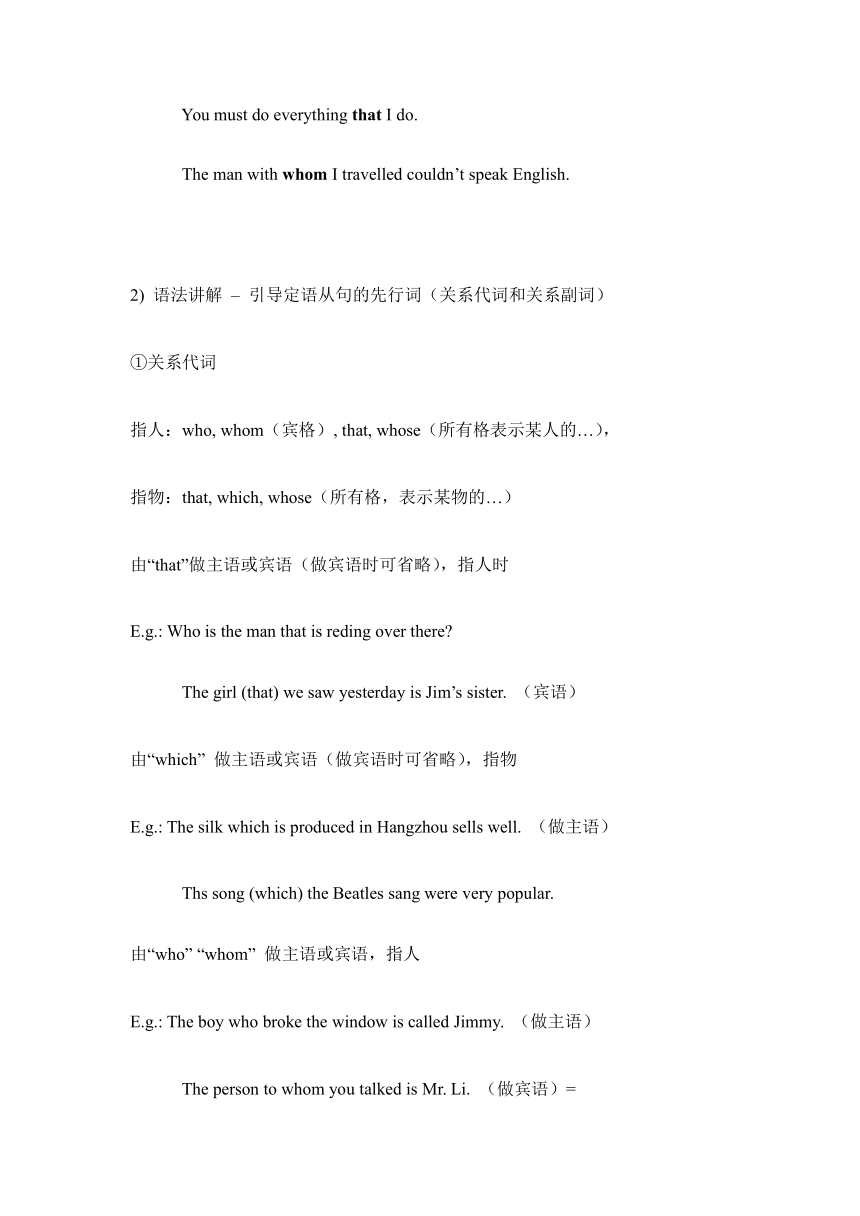外研版(2019)选择性必修 第四册Unit 4 Everyday economics Using Language Grammar定语从句教学设计
文档属性
| 名称 | 外研版(2019)选择性必修 第四册Unit 4 Everyday economics Using Language Grammar定语从句教学设计 |  | |
| 格式 | docx | ||
| 文件大小 | 21.2KB | ||
| 资源类型 | 教案 | ||
| 版本资源 | 外研版(2019) | ||
| 科目 | 英语 | ||
| 更新时间 | 2023-02-27 15:50:54 | ||
图片预览



文档简介
Unit 4 Everyday Economics Using Language 1:Grammar
定语从句 教学设计
教学目标:
学生能够理解、掌握并运用宾、定语从句:
1.掌握限定性定语从句及非限定性定语从句的用法
2.掌握引导定语从句关系代词及关系副词的用法,丰富学生语法知识,形成独立学习的能力,能够运用这些知识去解决定语从句的习题。
3.让学生主动参与、感知、积累、理解关系代词的过程,让学生学会关系代词的用法,学会探究解决问题。
教学重难点:
【重点】 掌握定语从句的基本用法
【难点】 定语从句关系代词及关系副词的用法
教学过程:
环节一:导入学习
Hello everyone! Welcome to my class. At the beginning of the class, please look at sentences on the screen and answer the question(练习1):
a. This is a place where roses grow wild.
b. The biggest challenge at the initial phases was to persuade people to work for me, which was totally outside my experience.
What does “where” refer to in sentence (a)
What does “which” refer to in the sentence (b)
Which sentence contains a clause with essential information about the subject
Which sentence contain a clause with extra information about the subject
Let's start today's class with the mentioned questions.
环节二:语法讲解及扩展内容
1)语法讲解 – 先行词
Today, we will learn attributive clause.
在复合句(即从句)中,修饰某一名词或代词的从句叫定语从句。
E.g.: The man who lives next to us is a policeman.
You must do everything that I do.
The man with whom I travelled couldn’t speak English.
2) 语法讲解 – 引导定语从句的先行词(关系代词和关系副词)
①关系代词
指人:who, whom(宾格), that, whose(所有格表示某人的…),
指物:that, which, whose(所有格,表示某物的…)
由“that”做主语或宾语(做宾语时可省略),指人时
E.g.: Who is the man that is reding over there
The girl (that) we saw yesterday is Jim’s sister. (宾语)
由“which” 做主语或宾语(做宾语时可省略),指物
E.g.: The silk which is produced in Hangzhou sells well. (做主语)
Ths song (which) the Beatles sang were very popular.
由“who” “whom” 做主语或宾语,指人
E.g.: The boy who broke the window is called Jimmy. (做主语)
The person to whom you talked is Mr. Li. (做宾语)=
The person (whom) you talked to is Mr. Li. (做宾语)
由“whose” 所有格做定语,指…的人,…的物
E.g.: People whose rent have been raised can appeal.
His parents wouldn’t let her marry anyone whose family was poor.
I live in a house whose windows face the south.
②关系副词
Where表示地点,when表示时间,why表示原因
E.g.: 1994 was the year when he was born.
This is the hotel where we were staying last summer.
Give me one reason why we should help you.
关系副词相当于一个恰当的介词 + which,在从句中做状语
When = in/ at/ on… + which
Where = in/ at/ on… + which
Why = for… + which
E.g.: Do you still remember the day when (on which) we went to visit the museum together
This is the factory where (in which) my father once worked.
This is the reason why (for which) he was late for school.
2) 语法讲解 – 限定性定语从句与非限定性定语从句
①限定性定语从句
大多数定语从句都对所修饰词的意思加以限制,表示…的人(事),这类从句称为限定性定语从句(defining attributive clauses),也可称作限定性关系从句(defining relative clauses),由关系代词引出。
E.g.: The man who told me refused to tell me his name.
I saw soothing in the paper which might interest you.
This is the photo (that) I took.
②非限定性定语从句
还有一种定语从句为非限定性的,称为非限定性定语从句(non-defining attributive clauses),这种从句,对所修饰的名词没有限制意义的作用,而只补充一点情况,与主语关系不紧密,把它们拿掉,句子照样成立。它们和所修饰的名词之间常加一个逗号,仿佛是并列句。只有who(m),whose和which等关系代词能引出这类从句(that不能)。
E.g.: She gave me this sweater, which she had knitted herself.
My daughter, who is in Boston now, is coming home next week.
Tom, whom everyone suspected, turned out to be innocent.
环节三:拓展练习
环节四:总结课堂
Homework: write an introduction to something you have bought recently using attributive clauses where appropriate.
定语从句 教学设计
教学目标:
学生能够理解、掌握并运用宾、定语从句:
1.掌握限定性定语从句及非限定性定语从句的用法
2.掌握引导定语从句关系代词及关系副词的用法,丰富学生语法知识,形成独立学习的能力,能够运用这些知识去解决定语从句的习题。
3.让学生主动参与、感知、积累、理解关系代词的过程,让学生学会关系代词的用法,学会探究解决问题。
教学重难点:
【重点】 掌握定语从句的基本用法
【难点】 定语从句关系代词及关系副词的用法
教学过程:
环节一:导入学习
Hello everyone! Welcome to my class. At the beginning of the class, please look at sentences on the screen and answer the question(练习1):
a. This is a place where roses grow wild.
b. The biggest challenge at the initial phases was to persuade people to work for me, which was totally outside my experience.
What does “where” refer to in sentence (a)
What does “which” refer to in the sentence (b)
Which sentence contains a clause with essential information about the subject
Which sentence contain a clause with extra information about the subject
Let's start today's class with the mentioned questions.
环节二:语法讲解及扩展内容
1)语法讲解 – 先行词
Today, we will learn attributive clause.
在复合句(即从句)中,修饰某一名词或代词的从句叫定语从句。
E.g.: The man who lives next to us is a policeman.
You must do everything that I do.
The man with whom I travelled couldn’t speak English.
2) 语法讲解 – 引导定语从句的先行词(关系代词和关系副词)
①关系代词
指人:who, whom(宾格), that, whose(所有格表示某人的…),
指物:that, which, whose(所有格,表示某物的…)
由“that”做主语或宾语(做宾语时可省略),指人时
E.g.: Who is the man that is reding over there
The girl (that) we saw yesterday is Jim’s sister. (宾语)
由“which” 做主语或宾语(做宾语时可省略),指物
E.g.: The silk which is produced in Hangzhou sells well. (做主语)
Ths song (which) the Beatles sang were very popular.
由“who” “whom” 做主语或宾语,指人
E.g.: The boy who broke the window is called Jimmy. (做主语)
The person to whom you talked is Mr. Li. (做宾语)=
The person (whom) you talked to is Mr. Li. (做宾语)
由“whose” 所有格做定语,指…的人,…的物
E.g.: People whose rent have been raised can appeal.
His parents wouldn’t let her marry anyone whose family was poor.
I live in a house whose windows face the south.
②关系副词
Where表示地点,when表示时间,why表示原因
E.g.: 1994 was the year when he was born.
This is the hotel where we were staying last summer.
Give me one reason why we should help you.
关系副词相当于一个恰当的介词 + which,在从句中做状语
When = in/ at/ on… + which
Where = in/ at/ on… + which
Why = for… + which
E.g.: Do you still remember the day when (on which) we went to visit the museum together
This is the factory where (in which) my father once worked.
This is the reason why (for which) he was late for school.
2) 语法讲解 – 限定性定语从句与非限定性定语从句
①限定性定语从句
大多数定语从句都对所修饰词的意思加以限制,表示…的人(事),这类从句称为限定性定语从句(defining attributive clauses),也可称作限定性关系从句(defining relative clauses),由关系代词引出。
E.g.: The man who told me refused to tell me his name.
I saw soothing in the paper which might interest you.
This is the photo (that) I took.
②非限定性定语从句
还有一种定语从句为非限定性的,称为非限定性定语从句(non-defining attributive clauses),这种从句,对所修饰的名词没有限制意义的作用,而只补充一点情况,与主语关系不紧密,把它们拿掉,句子照样成立。它们和所修饰的名词之间常加一个逗号,仿佛是并列句。只有who(m),whose和which等关系代词能引出这类从句(that不能)。
E.g.: She gave me this sweater, which she had knitted herself.
My daughter, who is in Boston now, is coming home next week.
Tom, whom everyone suspected, turned out to be innocent.
环节三:拓展练习
环节四:总结课堂
Homework: write an introduction to something you have bought recently using attributive clauses where appropriate.
